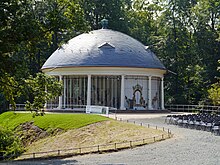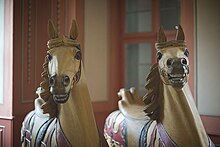Wilhelmsbad carousel
The Wilhelmsbader Karussell is a monumental carousel in the Wilhelmsbad State Park in Hanau from 1780. It is the oldest preserved fixed carousel in the world.
Building
architecture
The carousel was placed in the Wilhelmsbad park between the light boskett in front of the Kurhaus and the dark forest behind.
The designer was Franz Ludwig Cancrin (* 1738; † 1816). The construction site for the carousel was an abandoned quarry. A two-story building was placed there. On the lower floor, about four meters high, it contained the room with the drive mechanism, the upper floor was the visible carousel itself. The excavation for the construction of the neighboring pond was poured around the building so that only this upper part was visible and on seems to be enthroned on the hill. The carousel is designed as an antique round building, which is surrounded by two rows of 12 columns each in the Tuscan order . Horses and wagons move between the two rows of columns as figures of the carousel.
This look hides the following construction: The dome of the carousel roof rests on the circle of the outer pillars. It itself consists of a roof structure from which the wreath of the inner pillars hangs, from which the inner floor of the carousel is suspended. Between this inner floor and the outer foundation there is a 25 cm wide gap in which a 70 cm high ring runs on which the figures of the carousel are mounted. This ring is turned by the mechanism below. This creates the appearance of a static building in which the figures move between the columns.
In order to statically secure this construction and at the same time to be able to form a dome as a roof, through which no struts run, Cancrin designed a system of six trusses . Each of these trusses rests on a pair of opposite pillars and is - in order to be able to form the dome - broken twice. The intersection of the trusses is highly complex. Two iron bands at the base of the dome formed a ring anchor and absorbed their horizontal thrust.
The original equipment consisted of two Phaetons , each with two harnessed horses and two individual riding horses. The figures were made of wood and painted, the carriages lined with plush , the horses wore real saddles and bridles .
mechanics
The axis of the carousel was about three feet thick and ran in iron bearings. The lower camp was located in a shaft about three meters deep, which dates from the time the quarry was in operation. The upper end was stored in the floor of the carousel that hung from the dome. In the middle, the axle was also stored in a wooden frame. In the upper area of the axle, sixteen beams, which were supported like the spokes of a wheel, formed the connection to the ring on which the figures of the carousel stand. It was driven from the underground lower floor, which is not visible from the outside, initially by people.
history
Construction and historical operation
The carousel was built in 1780 as the main attraction in the park of the Wilhelmsbad spa complex . It should cost 400 guilders . After a change of plan, it was almost 1,500 guilders. Like the other attractions in the park, the carousel could only be used for a fee. It was 24 cruisers , for which 12 laps were driven.
The carousel had been in operation for over 85 years when it was damaged by Prussian artillery in the war of 1866 . The equipment was also damaged by French prisoners of war from the Franco-German War and auctioned off in 1872 . In 1873 the building was to be auctioned for demolition, but this prevented public protests.
In 1896, the carpenter and building contractor Bernhard Scherf from Hanau leased the carousel. At a cost of 20,000 marks , he repaired it and modernized it: bodies and horses were made by Fritz Bothmann u. Glück, Maschinen- und Carousselfabrik procured new. The number of chariots was increased to four and that of horses to a total of 16. This is the equipment that has been preserved to this day. A gas engine was also installed for operation . From 1898 until the First World War , the operation ran again. Restoration began in 1934 and the carousel is said to have run again in 1936.
During World War II , an explosive bomb hit the carousel. The iron ring anchor was blown up and one of the twelve supporting pillars fell over. As a result, the actually static part of the system slipped against the rotating mechanism, wedged it in and locked it in such a way that the carousel could no longer rotate. The external war damage was not repaired until 1964, but the mechanics were no longer repaired. So the carousel didn't spin again. The figures of the carousel were initially stored in the Comoedienhaus Wilhelmsbad . After this went back into operation in 1968, they were placed on the carousel again in 1976 and secured by grids that were mounted between the outer columns.
Recommissioning in 2016
After years of efforts by the State of Hesse , as the current owner of the Wilhelmsbad State Park , its responsible administration of the State Palaces and Gardens of Hesse and the sponsoring association for the carousel in the Hanau-Wilhelmsbad State Park , the carousel was restored from 2007 . Additional money came from donations, sponsorships for individual carousel horses, through grants from the public sector and from the German Foundation for Monument Protection . After years of work, the carousel was restored to working order and put back into operation on July 22, 2016.
literature
- Thomas Ludwig: The carousel in the Wilhelmsbad in Hanau . In: Die Gartenkunst 1/2016, pp. 57–74.
- Carola Nathan: 24 cruisers "to be driven around for 12 times" . In: Monuments June 2008.
Web links
Remarks
- ↑ The county of Hanau had since 1736 a Sekundogenitur of Hesse-Kassel , later the Electorate of Hesse , which was in the war of 1866 against Prussia on the losing side.
Individual evidence
- ↑ Luise Glaser-Lotz, Hanau: Oldest carousel in the world: Premiere for the “Miracle of Hanau” . In: FAZ.NET . July 25, 2016, ISSN 0174-4909 ( faz.net [accessed February 15, 2018]).
- ↑ Frankfurter Rundschau: Hanau: The oldest carousel in the world . In: Frankfurter Rundschau . ( fr.de [accessed on February 15, 2018]).
- ^ Thomas Ludwig: The carousel in the Wilhelmsbad in Hanau . In: Die Gartenkunst 1/2016, p. 63.
- ↑ Ludwig, p. 70.
- ↑ Ludwig p. 63.
- ↑ Ludwig, p. 65.
- ↑ Ludwig, p. 72.
- ↑ Ludwig, p. 65f.
- ↑ Ludwig, p. 70.
- ↑ Ludwig, p. 70.
- ↑ Ludwig, p. 72.
- ↑ Ludwig, p. 72.
- ↑ Ludwig, p. 72.
- ↑ Ludwig, p. 72.
- ↑ Ludwig, p. 73.
- ↑ Wilhelmsbad carousel
- ↑ Ludwig, p. 72.
- ↑ Carola Nathan: 24 cruisers "to drive around for 12 times" . In: Monuments June 2008, accessed March 23, 2017.
- ↑ 5000 lights in Wilhelmsbader Park. May 19, 2016. Retrieved March 23, 2017 .
Coordinates: 50 ° 8 ′ 50.3 " N , 8 ° 52 ′ 49.1" E


